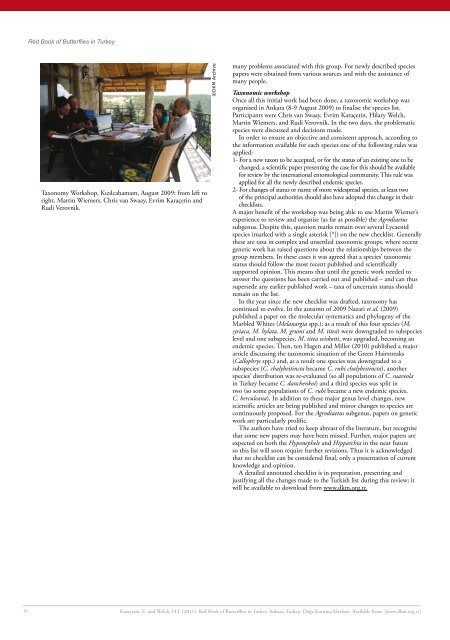Red Book of Butterflies in Turkey Red Book of Butterflies in Turkey
Red Book of Butterflies in Turkey Red Book of Butterflies in Turkey
Red Book of Butterflies in Turkey Red Book of Butterflies in Turkey
You also want an ePaper? Increase the reach of your titles
YUMPU automatically turns print PDFs into web optimized ePapers that Google loves.
10<br />
<strong>Red</strong> <strong>Book</strong> <strong>of</strong> <strong>Butterflies</strong> <strong>in</strong> <strong>Turkey</strong><br />
Taxonomy Workshop, Kızılcahamam, August 2009: from left to<br />
right, Mart<strong>in</strong> Wiemers, Chris van Swaay, Evrim Karaçet<strong>in</strong> and<br />
Rudi Verovnik.<br />
©DKM Archive<br />
many problems associated with this group. For newly described species<br />
papers were obta<strong>in</strong>ed from various sources and with the assistance <strong>of</strong><br />
many people.<br />
Taxonomic workshop<br />
Once all this <strong>in</strong>itial work had been done, a taxonomic workshop was<br />
organised <strong>in</strong> Ankara (8-9 August 2009) to f<strong>in</strong>alise the species list.<br />
Participants were Chris van Swaay, Evrim Karaçet<strong>in</strong>, Hilary Welch,<br />
Mart<strong>in</strong> Wiemers, and Rudi Verovnik. In the two days, the problematic<br />
species were discussed and decisions made.<br />
In order to ensure an objective and consistent approach, accord<strong>in</strong>g to<br />
the <strong>in</strong>formation available for each species one <strong>of</strong> the follow<strong>in</strong>g rules was<br />
applied:<br />
1- For a new taxon to be accepted, or for the status <strong>of</strong> an exist<strong>in</strong>g one to be<br />
changed, a scientific paper present<strong>in</strong>g the case for this should be available<br />
for review by the <strong>in</strong>ternational entomological community. This rule was<br />
applied for all the newly described endemic species.<br />
2- For changes <strong>of</strong> status or name <strong>of</strong> more widespread species, at least two<br />
<strong>of</strong> the pr<strong>in</strong>cipal authorities should also have adopted this change <strong>in</strong> their<br />
checklists.<br />
A major benefit <strong>of</strong> the workshop was be<strong>in</strong>g able to use Mart<strong>in</strong> Wiemer’s<br />
experience to review and organise (as far as possible) the Agrodiaetus<br />
subgenus. Despite this, question marks rema<strong>in</strong> over several Lycaenid<br />
species (marked with a s<strong>in</strong>gle asterisk [*]) on the new checklist. Generally<br />
these are taxa <strong>in</strong> complex and unsettled taxonomic groups, where recent<br />
genetic work has raised questions about the relationships between the<br />
group members. In these cases it was agreed that a species’ taxonomic<br />
status should follow the most recent published and scientifically<br />
supported op<strong>in</strong>ion. This means that until the genetic work needed to<br />
answer the questions has been carried out and published – and can thus<br />
supersede any earlier published work – taxa <strong>of</strong> uncerta<strong>in</strong> status should<br />
rema<strong>in</strong> on the list.<br />
In the year s<strong>in</strong>ce the new checklist was drafted, taxonomy has<br />
cont<strong>in</strong>ued to evolve. In the autumn <strong>of</strong> 2009 Nazari et al. (2009)<br />
published a paper on the molecular systematics and phylogeny <strong>of</strong> the<br />
Marbled Whites (Melanargia spp.); as a result <strong>of</strong> this four species (M.<br />
syriaca, M. hylata, M. grumi and M. titea) were downgraded to subspecies<br />
level and one subspecies, M. titea wiskotti, was upgraded, becom<strong>in</strong>g an<br />
endemic species. Then, ten Hagen and Miller (2010) published a major<br />
article discuss<strong>in</strong>g the taxonomic situation <strong>of</strong> the Green Hairstreaks<br />
(Callophrys spp.) and, as a result one species was downgraded to a<br />
subspecies (C. chalybeit<strong>in</strong>cta became C. rubi chalybeit<strong>in</strong>cta), another<br />
species’ distribution was re-evaluated (so all populations <strong>of</strong> C. suaveola<br />
<strong>in</strong> <strong>Turkey</strong> became C. danchenkoi) and a third species was split <strong>in</strong><br />
two (so some populations <strong>of</strong> C. rubi became a new endemic species,<br />
C. herculeana). In addition to these major genus level changes, new<br />
scientific articles are be<strong>in</strong>g published and m<strong>in</strong>or changes to species are<br />
cont<strong>in</strong>uously proposed. For the Agrodiaetus subgenus, papers on genetic<br />
work are particularly prolific.<br />
The authors have tried to keep abreast <strong>of</strong> the literature, but recognise<br />
that some new papers may have been missed. Further, major papers are<br />
expected on both the Hyponephele and Hipparchia <strong>in</strong> the near future<br />
so this list will soon require further revisions. Thus it is acknowledged<br />
that no checklist can be considered f<strong>in</strong>al, only a presentation <strong>of</strong> current<br />
knowledge and op<strong>in</strong>ion.<br />
A detailed annotated checklist is <strong>in</strong> preparation, present<strong>in</strong>g and<br />
justify<strong>in</strong>g all the changes made to the Turkish list dur<strong>in</strong>g this review; it<br />
will be available to download from www.dkm.org.tr.<br />
Karaçet<strong>in</strong>, E. and Welch, H.J. (2011). <strong>Red</strong> <strong>Book</strong> <strong>of</strong> <strong>Butterflies</strong> <strong>in</strong> <strong>Turkey</strong>. Ankara, <strong>Turkey</strong>: Doğa Koruma Merkezi. Available from: [www.dkm.org.tr]


